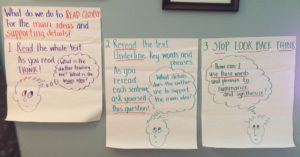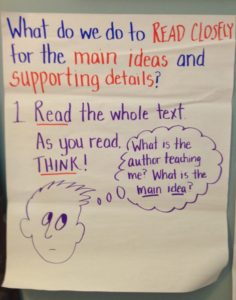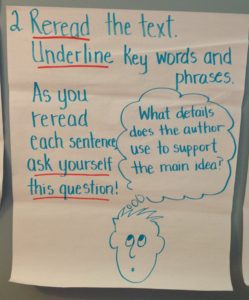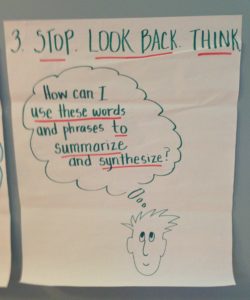
So…I’ve been getting a lot of questions about “anchor charts” for “close reading.” I’ve been hesitant because I don’t want students to consider close reading as a lock-step process. Close reading is the simultaneous orchestration of multiple skills, used fluidly and iteratively. BUT there are potential benefits when we use an initial anchor chart as a way to start conversations about close reading with our students. So I spent some time today playing around with a chart. (So glad my daughter has a BIG eraser :).)



A couple of my thoughts as I created this –
- Notice how the language addresses “you” and “we.” I want the student to see this as part of a conversation about what “we” all do as a community of readers.
- I included the questions in thought bubbles as a way to scaffold for “this is a thinking experience”; the reader has to be actively engaged.
- I tried to get at how you don’t read and then stop to think; instead, you think as you read. Synthesis does not happen after reading – it’s continually going on as we read, gathering more and more information.
- I had to let go of an anchor chart that is all inclusive; in other words, this anchor chart only gets at determining the main idea and summarizing the text with key details. What’s missing is explaining how the details support the main idea. When I move on to getting at this or to using this information to go back and reread another time to consider how the author structured the text to convey the main idea (CCSS R.I. 4.5) or to explain how an author uses reasons and evidence to support particular points in a text (CCSS R.I. 4.8) etc., I will have to add on to this chart or develop a new one. My suggestion would be to have the students help you consider how to add on/modify the steps as you deepen your close reading practice.
Even as I’m writing this and looking at the charts, there are changes I’d make. Ugh!!!! Have to let go of that at some point and trust the students to get what I’m trying to say – with this anchor chart, a lot of modeling, and intensive one-to-one or small group coaching. AND that’s another reminder that an anchor chart is just a beginning to the conversation and not a static document posted forever on the wall. Ideally, it should be a living document that together, the students and I, modify, revise, expand.
